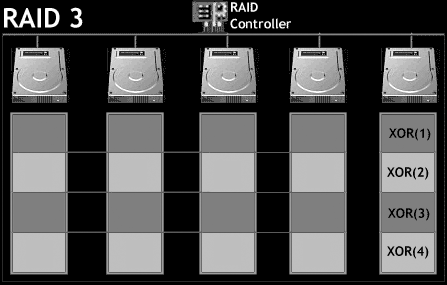Like RAID 2,
RAID 3 is not supported under Windows Server. In addition, RAID 3 reserves the dedicated parity-disk model for active recovery. But RAID 3 bests RAID 2 by moving up to byte-level data striping (8 bits in a byte), and switching to a more effective ECC scheme.
XOR is the shortened version of “eXclusive OR.” XOR is just another algorithm for treating data, but it’s far more simple than
Hamming Code. As a basic Boolean logic operator, the end result of a XOR operation should result in a true or false verdict, or in the case of RAID 3, even or odd. XOR is generally an odd parity. When fed data ‘A’ and ‘B’, XOR asks if it’s true that
either one or the other (BUT NOT BOTH) of these values are “true”, i.e., odd. 0 + 0 = False (0; none are odd).
XOR makes for lightweight ECC, since XOR(any n-2) number of bytes with the result byte will allow you to reconstruct byte n. For fault tolerance, this means that one “piece” of data can get corrupted, and yet it can be recovered as long as the XOR parity information is available. Because of this, multiple parity disks aren’t needed.

